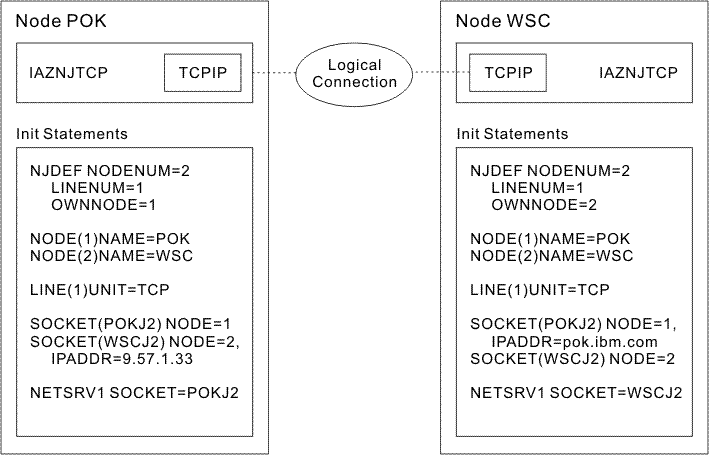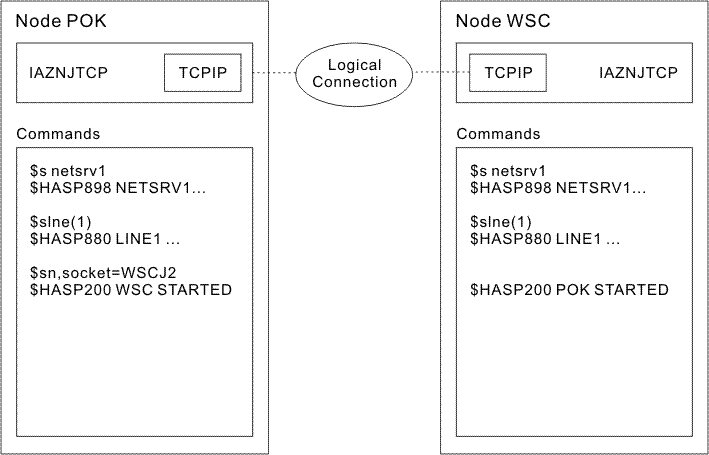 z/OS JES2 Initialization and Tuning Guide
z/OS JES2 Initialization and Tuning Guide
 z/OS JES2 Initialization and Tuning Guide
z/OS JES2 Initialization and Tuning Guide
|
Previous topic |
Next topic |
Contents |
Contact z/OS |
Library |
PDF
Example z/OS JES2 Initialization and Tuning Guide SA32-0991-00 |
|
|
Here is a simple two node network and the JES2 initialization statements
required to communicate between the two nodes using NJE/TCP:
Figure 1. Example
of a two node network and the JES2 initialization statements required
to communicate between the two nodes using NJE/TCP
 This example defines two nodes, POK and WSC. Each node has similar NJEDEF and NODE definitions, with NODE(1) defined as POK and NODE(2) defined as WSC. Each node then also needs to define a NETSRV device, a local socket defining the IP address and port that NETSRV is to listen on, and a non-local socket defining the IP address and port of each connection to be established with other network nodes. In this case, there is only one of those. On node POK, a single NETSRV device is defined, pointing to socket POKJ2. SOCKET(POKJ2) specifies the local node number (1) on the NODE= parameter, and takes the default values for IPADDR= and PORT=. Therefore, when NETSRV1 is eventually started, it listens on all IP addresses, and because SECURE=YES is not specified, it uses the port associated with VMNET (175). The non-local socket for the connection to node WSC, defined by the SOCKET(WSCJ2) statement, indicates that the connection is associated with node 2 (per the NODE=2 keyword), and specifies an IP address of 9.57.1.33. In this case, the explicit IP address is specified in dotted-decimal format. Because PORT= is not specified, the default value (VMNET, or 175) is also used. On node WSC, a single NETSRV device is defined, pointing to socket WSCJ2. SOCKET(WSCJ2) specifies the local node number (2) on the NODE= parameter, and takes the default values for IPADDR= and PORT=. The non-local socket for the connection to node POK, defined by the SOCKET(POKJ2) statement, indicates that the connection is associated with node 1 (per the NODE=1 keyword), and specifies an IP address of pok.ibm.com. In this case, a symbolic address is specified rather than an explicit address; either can be used. Because PORT= is not specified, the default value (VMNET, or 175) is also used. To connect the two nodes, processing is very similar to SNA and BSC NJE. You can use the $SLINEnnn command to activate the logical line that is to be used for the connection, and the $SN command to start networking on the connection. Figure 2. Example
of a two node network and the JES2 commands required to start networking
 First, on each end of the connection, you must start the NETSRV device and logical line with the $SNETSRV1 and $SLNE1 commands, respectively. Next, when you issue the $SN,SOCKET=WSCJ2 command, this tells NETSRV1 (by default) to initiate a connection between itself and the IP address that is provided on the SOCKET(WSCJ2) statement. Because NETSRV1 on node WSC is listening on this IP address and port, you can establish a connection successfully. You can also establish the connection by issuing $SN,SOCKET=POK from node WSC. Displaying the attributes of the NETSRVs, lines, and sockets on
both sides of the connection results in the following displays:
Note the following in the previous display:
Note: When associating an incoming request with a SOCKET,
you can only use the NODE= and SECURE= values to make that association;
the IPADDR= and PORT= values are ignored. This is because the inbound
IP address might not match what is specified on the SOCKET statement
because of the presence of firewalls, NAT translation, and so on.
The inbound port might not match as TCP/IP assigns an ephemeral port
value to the inbound socket, which in general cannot be predicted.
It is also possible that for an inbound connection, neither the IP
address nor the port matches the value that would have to be specified
if the connection were initiated from this end of the connection.
You must specify the correct values, though, to initiate the connection
successfully from either end of the connection.



|
 Copyright IBM Corporation 1990, 2014 Copyright IBM Corporation 1990, 2014 |